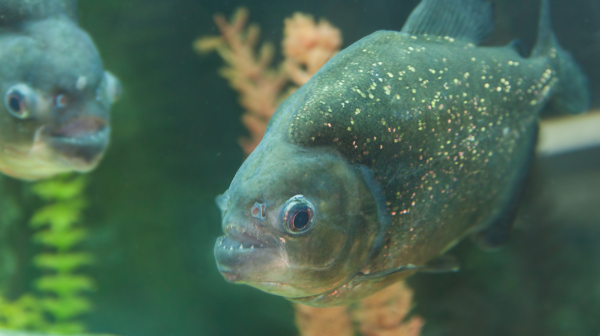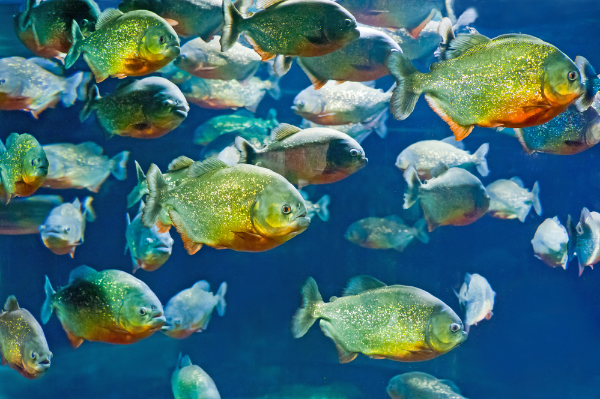Who doesn’t love a good piranha story? The idea of ferocious, razor-toothed fish swimming in freshwater rivers and lakes is the stuff of nightmares for many people. But just how dangerous are these creatures, really? And should you be worried about them if you’re spending time near water? Here’s a look at what you need to know about piranhas.

Piranha Description
Piranhas are a type of freshwater fish that is native to the rivers of South America. Piranhas are known for their sharp teeth and voracious appetite, and they have been known to attack and kill humans. Piranhas are typically red or brown in color, and they range in size from 10 to 20 cm. Piranhas typically live in groups of 20 to 30 fish, and they hunt in packs. Piranhas are opportunistic feeders, and they will eat anything that they can catch. Their diet typically consists of smaller fish, insects, and crustaceans. Piranhas are considered to be one of the most dangerous animals in the world, and they should be avoided at all cost.
Piranha Habitat
Piranhas are found in tropical rivers and streams in South America. They typically prefer slow-moving water with lots of vegetation, but can also be found in fast-flowing rivers. Piranhas are not particularly picky about their habitat and will even live in ponds and lakes. Piranhas are most active during the day, but will also feed at night. Piranhas typically eat fish, but will also eat crustaceans, mollusks, and insects. Piranhas are notorious for their sharp teeth and aggressive behavior, but they are actually relatively shy fish that only attack when they feel threatened or when food is scarce.
Piranha Diet
Piranhas are well-known for their sharp teeth and voracious appetite. But what do these ferocious fish actually eat? Piranhas are carnivores, meaning that they primarily feed on other animals. Smaller piranhas will eat insects, crustaceans, and other small creatures. Larger piranhas, on the other hand, will prey on larger animals such as reptiles, mammals, and even other fish. In fact, piranhas have been known to strip a carcass clean in just a few minutes. While Piranhas typically prefer live prey, they will also scavenge for food if necessary. All in all, Piranhas are opportunistic feeders that will eat just about anything they can get their teeth into.
Piranha Size
Piranhas are small to medium-sized freshwater fish that are found in South American rivers. They are known for their sharp teeth and ferocious appetite, and they have been known to attack and eat other animals, including humans. Piranhas typically range in size from 5 to 10 inches long, with the largest specimens reaching up to 15 inches in length. Piranhas are relatively slender fish, with long, pointed fins and a torpedo-shaped body. Their teeth are designed for slicing, and their jaws are extremely powerful. Piranhas are opportunistic predators, and they will eat just about anything they can catch. In the wild, they typically feed on smaller fish, insects, and crustaceans. However, they have been known to attack larger animals, including cows and humans. Piranhas are not usually considered dangerous to humans unless they are provoked or feel threatened. However, it is still advisable to exercise caution if you find yourself in piranha-infested waters.

Piranha Lifespan
In the wild, piranhas typically have a lifespan of about 10 years. However, Piranhas kept in captivity can live up to 20 years. The oldest recorded piranha was 25 years old. Piranhas reach maturity at 3-4 years old. Piranhas are relatively short-lived fish compared to other species. This is likely due to their high metabolism and active lifestyle. Piranhas are constantly swimming and searching for food, which takes a lot of energy. Additionally, Piranhas are often preyed upon by larger fish, birds, and mammals. As a result, they have a high mortality rate, with only a small percentage of young fish surviving to adulthood.
Piranha Behavior
Piranhas are a type of fish that is known for its aggressive behavior. Piranhas are found in rivers in South America. Piranhas typically live in groups of 20-30 fish, but groups of up to 100 fish have been observed. Piranhas are opportunistic feeders and will eat almost anything that they can catch. Piranha behavior is highly variable and depends on the species, age, and size of the fish. For example, young piranhas tend to be more shy and will only attack if they feel threatened. However, as piranhas grow older, they become more aggressive and are more likely to attack even when they are not threatened. Piranhas have sharp teeth that they use to bite their prey. Piranhas also have a strong jaw that helps them to tear their prey apart. Piranhas typically hunt in groups and will swarm their prey, making it difficult for the prey to escape. Piranhas are considered to be one of the most dangerous animals in South America and have been known to killed humans.
Piranha Speed
Piranhas are well-known for their sharp teeth and ferocious appetite. But what many people don’t realize is that these fish are also incredibly fast. Piranhas can reach speeds of up to 25 miles per hour in short bursts, making them one of the fastest fish in the world. This speed is essential for hunting, as it allows piranhas to quickly close in on their prey. But it also comes in handy for avoiding predators. Piranhas have few natural enemies, but when they are threatened, their speed allows them to make a quick getaway. So next time you’re in the Amazon, beware of these fast and ferocious fish!
Piranha Hunting
Piranha hunting is a popular sport in many parts of the world. Piranhas are a type of fish that is known for its sharp teeth and aggressive behavior. Piranhas are native to the Amazon River basin, but they can also be found in other freshwater habitats. Piranha hunting usually takes place in boats, and the goal is to catch as many fish as possible. Piranhas are often caught with baitfish, and the meat is typically used for food. Piranha hunting can be dangerous, and it is important to take safety precautions when participating in this activity.
Conclusion
Piranha are a type of fish that is known for its razor sharp teeth and aggressive behavior. They can be found in many different parts of the world, including South America, Africa, and Australia. While they may look dangerous, piranha are actually quite timid and will usually only attack humans if they feel threatened. Piranha are a popular food fish and their meat is considered to be a delicacy in some parts of the world.
Frequently Asked Question


